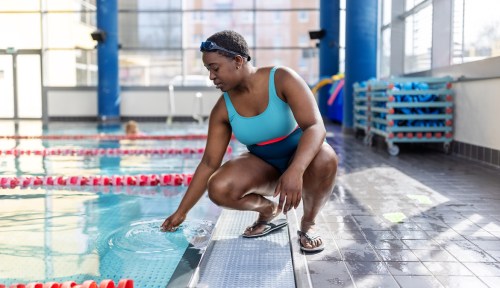Our editors independently select these products. Making a purchase through our links may earn Well+Good a commission
A Functional Medicine Doctor Shares Her No. 1 Tip for Exercising With Arthritis
If you're considering exercising with arthritis, learn why movement is so important, and how to make sure your workouts help, and don't hurt.

It might seem counterintuitive to move much when you have a painful condition that can also cause severe fatigue. But if you’re one of the 1.5 million Americans who have rheumatoid arthritis (RA)—or one of the 32.5 million with osteoarthritis—you should know that exercise has been found to be one of the best ways to help alleviate symptoms like joint pain, swelling, stiffness, and tenderness. The key is making sure you exercise in ways that benefit instead of harm your body, says Tamika Henry, MD, a board-certified family physician, founder of Unlimited Health Institute, and author of The Unlimited You Detox.
Experts in This Article
board-certified family physician, founder of Unlimited Health Institute, and author of The Unlimited You Detox.
RA occurs when the immune system attacks the synovium, tissue that lines the joints and helps them move smoothly. When the synovium becomes inflamed, it thickens, causing swollen, tender joints, and making movement painful and difficult. While both RA and osteoarthritis involve inflammation of the joint lining, they differ in that osteoarthritis also causes weakening and deterioration of the entire joint including bones and connective tissue. However, both types of arthritis can be helped by exercise, says Dr. Henry, who was diagnosed with juvenile RA as a child.
“Exercise helps to maintain mobility and can help with decreasing further joint stiffening,” she says. “Exercise also increases blood flow to the area which can increase muscle strength and has been associated with decrease in pain.”
Why your exercise routine might need to change
Dr. Henry says those with arthritis need to think about “preservation of joints” when exercising—which may mean changing your approach if you were doing HIIT or CrossFit prior to your diagnosis. “Activity that is high impact may cause further pain,” she says. “The wrong exercise can cause further swelling and inflammation, and could lead to even more restricted use of the joint.”
Dr. Henry’s advice if you have arthritis: Avoid workouts that involve jumping, running, or any other movement that puts heavy impact on the joints. Instead, stick to activities that are low impact and promote flexibility, range of motion, and involve both cardio and strength. Top options include yoga, tai chi, stretching, walking, water aerobics, swimming, cycling, and even gardening.
Resistance training has also been found to be beneficial if you have RA, improving joint function, pain, stiffness, physical functioning, and strength, including grip strength.
Maintaining grip strength if you have RA is particularly important because the condition commonly affects joints in the hands and fingers, which can lead to decreased mobility and increased stiffness, says Dr. Henry. That’s why she advises adding hand and finger exercises to your routine such as:
- Squeezing a soft rubber ball
- Opening and closing your fists
- Making a circle like the shape of an “O” with your fingers and thumb
- Alternating finger taps between your thumb, and index, middle, ring, and fifth fingers
Keeping the whole body healthy
While exercise is one piece of the puzzle, managing arthritis requires a whole-body approach that keeps inflammation levels low through healthy lifestyle choices, says Dr. Henry. “Build up the muscles around the joint, stretch, and drink water to help hydrate the joints,” she says. “Consider anti-inflammatory supplements like turmeric, fish oil, and glutathione. Avoid processed foods and high-sugar content beverages. Also don’t forget to get adequate sleep. Your body heals and repairs itself while you sleep.”
And if you’re having a flare-up or just don’t feel up to doing much, it’s okay to take it easy—rest can help reduce inflammation and fatigue, and help conserve your energy for when you’re feeling better. With arthritis—as with all things in life—balance is key, and listening to what your body is telling you is always a smart idea.
Sign Up for Our Daily Newsletter
Get all the latest in wellness, trends, food, fitness, beauty, and more delivered right to your inbox.
Got it, you've been added to our email list.










